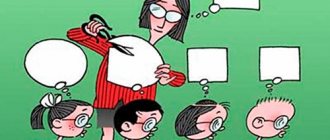Any morning can be good! Even if you are a night owl and never a morning person! And those who doubt it are usually told the story of how one sleepy office worker poured an energy drink into his home coffee machine instead of water. And only halfway to the office I realized that I had forgotten to use my car and was walking.
There are, of course, other ways to make your morning good, which we will tell you about in our “Self-Knowledge” and “Cognitive Science” programs. And today we will talk about a dynamic stereotype and how it is formed, functions, destroyed, and rebuilt.
Looking ahead a little, let’s clarify that making coffee in the morning and driving a personal car to work are dynamic stereotypes. But if you forget to do the usual set of actions - walk to the parking lot, get into the car and drive away - this will be an example of a violation of the dynamic stereotype. And all that is needed for this is for one small inaccuracy to creep into the previous dynamic stereotype.
However, we promised to get ahead not very far, but only a little, so let’s go back to the beginning and start with what a dynamic stereotype is.
What is a dynamic stereotype and how does it work?
So, a dynamic stereotype is a complex conditioned reflex reaction that is developed through repeated repetitions of any actions or situations by forming a response to external stimuli. In essence, a dynamic stereotype is a sequence of conditioned reflex acts that occur in a certain order.
The term “dynamic stereotype” was introduced into scientific circulation by the first Russian Nobel Prize laureate, academician Ivan Petrovich Pavlov (1849-1936), who devoted his life to the study of higher nervous activity, conditioned and unconditioned reflexes in mammals. Actually, a dynamic stereotype is a complex conditioned reflex, formed under the influence of certain regularly recurring situations and circumstances. We can also say that a dynamic stereotype is the ability of the brain to combine individual reflex acts into a system so that they occur in the required sequence.
Let us clarify that a stereotype is a part of past experience, fixed in the mind and constantly used to solve standard problems. Alternatively, we can say that this is an assessment of something, formed on the basis of previous experience and predetermining one or another reaction to an event or phenomenon.
The definition of “dynamic” implies that the stereotype can be dynamic. In particular, it should gradually form, be modified when the situation changes, be destroyed if it turns out to be “unclaimed” by circumstances, and be restored again if the conditions in which it was formed are restored.
Pavlov repeatedly addressed the topic of conditioned reflexes and dynamic stereotypes in his works, which can be found in the complete collected works [I. Pavlov, 1951]. In later years, interest in the topic did not fade away, as evidenced by further research. In particular, his foreign colleagues turned to Pavlov’s works. An example is the review of Pavlov's conceptualization of the dynamic stereotype in the theory of higher nervous activity (“Pavlov’s Conceptualization of the Dynamic Stereotype in the Theory of Higher Nervous Activity”) [G. Windholz, 1996].
Among the domestic studies recognized by the general scientific community, it is worth mentioning the work “Role of extrapolation and dynamic stereotype in the mechanisms of the formation and improvement of adequate motor coordinations” [N. Zimkin, 1982].
And for a wide range of readers the book “Dynamic Stereotypes, or Information Imprints of Reality”, published at the turn of the millennium [K. Sudakov, 2002]. By the way, the author of this book considers “Dynamic stereotype as a systemic property of the brain,” and his work at one time aroused the interest of foreign scientists and was translated into English [K. Sudakov, 2001].
And even if a person does not know the term “dynamic stereotype,” examples of such conditioned reflex reactions permeate his entire life from early childhood. Walking, running, swimming, using a spoon and fork, tying shoelaces and buttoning buttons are one or another dynamic stereotype of skills developed by repeated repetitions of the same action. These were the simplest examples of dynamic stereotypes, but these include not only motor skills.
There are also more complex dynamic stereotypes. However, no matter what dynamic stereotype you take, the basis, in any case, is the repetition of actions, simple or complex, performed daily or seasonally, at a certain time or in certain circumstances.
For example, you need to get up in the morning and sleep at night, when playing football you kick the ball with your feet, and when playing basketball you throw it with your hands, in winter you need to wear warm clothes and in summer, you need to write lightly, you need to write from left to right, and when you come to work in the office, you need first drink coffee and sort out the mail. In principle, any work, play, sports, mental, production activity is a dynamic stereotype.
If desired, you can create an algorithm for the actions of a driver getting behind the wheel of a car, a milling machine operator turning on a milling machine, a janitor sweeping the street, a chemist conducting experiments, a musician performing a piece of music.
However, a driver, milling machine operator, janitor, chemist, musician, or representative of any other profession who has sufficient practical experience performs his algorithm without thinking about the sequence before each swing of a broom, turn of the steering wheel or touch of the piano keys.
This is a dynamic stereotype in action. It works as a coherent system of conditioned reflex processes, on the basis of which habits and skills are formed. This system allows a person to perform a familiar set of actions with maximum efficiency, without spending time and effort on thinking about their sequence, technology or expediency.
To make it easier to understand the essence of the phenomenon, imagine that the driver, every time he got behind the wheel, would be forced to remember that he first needs to turn on the ignition, then squeeze the clutch, then make sure there are no obstacles and start driving. Or, before each lesson, a chemistry teacher would remember how to properly attach a test tube and what should be poured where: sulfuric acid into water or water into sulfuric acid. And any person, before writing or typing something, would remember how to hold a pen correctly or where the letters are on the keyboard.
A dynamic stereotype of writing is also a certain sequence of reflex acts, starting from how to hold a pen correctly and ending with the design of the text. On this same basis, by the way, a dynamic stereotype of mirror writing is formed, when a person writes not with his right hand, but with his left hand, and not from left to right, but from right to left.
Such a practical restructuring of the dynamic stereotype actually does not take much time, because the foundation has already been laid. And the pace of mirror writing after some training can be almost the same as usual, as can be seen in the example of the video “Mirror Writing”:
Those interested, by the way, can try to learn “mirror writing.” Fortunately, today detailed developments on this topic are available and even a plan for laboratory work “Developing the skill of mirror writing” for the 9th grade of a secondary school [infourok.ru, 2019].
However, if for some curious right-handers the restructuring of the dynamic writing stereotype is just an experiment, for many left-handers “mirror writing” becomes a real problem, because they cannot write as needed and fail to form a standard dynamic writing stereotype.
As a rule, they require the help of teachers and psychologists. Some explanations and practical tips for working with “left-handed” children can be found in the special video “Left-handedness in a child. Mirror letter. A left-handed child,” the author of which is a primary school teacher with extensive practical experience:
Of course, it happens that the simplest actions seem difficult not only for left-handed people. However, this usually means that the number of repetitions of the action was not sufficient to bring the skill to automaticity.
In addition to facilitating the daily routine of actions, dynamic stereotypes help a person adapt to habitually changing situations and circumstances. For example, to the fact that day gives way to night, winter gives way to autumn, physics lesson gives way to physical education lesson. Thus, snow falling in the middle of winter will not surprise anyone (except perhaps representatives of the housing and communal services sector). But if snow falls in mid-July, almost all residents of the northern hemisphere, where it is like summer from June to August, will be surprised.
By the way, accepting the same type of recurring phenomena as the norm and being surprised at phenomena that fall outside the usual norm are also dynamic stereotypes. And if earlier we spoke, in one form or another, mainly about the dynamic stereotype of skills, here there is a reason to think about the dynamic stereotype of thinking.
A little about thinking stereotypes
Regarding stereotypes of thinking, everything is not as clear as when it comes to the stereotypical repetition of actions associated with professional activities, sports or physical activity. Thus, it is the dynamic stereotypes of skills that allow one to learn once and for all to swim, ride a bicycle, write by hand, use a spoon, fork and many other useful objects.
Stereotypical thinking, in principle, also has many positive aspects. For example, having noticed in time in the dark a company of gloomy, unfriendly young people heading towards you, and identifying them as hooligans, you have a better chance of running away than if you doubt until the last minute and think that the four of them are going to the pharmacy for medicine. And when you see a knife in the hands of someone asking for directions to the pharmacy and there is no way to retreat, it is better to use self-defense techniques than to think outside the box and expect that this “pharmacy walker” is holding a knife in his hands just like that.
The formed dynamic stereotype of thinking and behavior can be useful in more peaceful situations. You will quickly become “your person” if you behave according to socially expected norms in an unfamiliar company, at a new job, at an industry conference, or when meeting relatives of the bride or groom. You will feel more comfortable if you begin to think “in unison” in a socially homogeneous team, be it a team of builders or a design bureau, the editorial office of a magazine or an international corporation.
In our subculture, any person who “stands out” from the general pattern and looks like a “black sheep” causes some mistrust. And this is also an example of a dynamic stereotype or stereotypical thinking. However, social stereotypes and other stereotypes of thinking and behavior can significantly harm you and your career if they contradict the norms accepted within your professional community or are completely outdated and are supported only by conservatives like you.
For example, in some remote village, where the problem is not only the Internet and mobile communications, but even bus communication with the regional center, a cautious and even wary attitude towards representatives of a non-titular nation or people from another continent will be considered the norm among residents. Simply because none of the village residents had experience working together or even simple human communication with people who came, for example, from Africa or Southeast Asia. However, in an international company and a multicultural environment, the lack of tolerance will be perceived negatively, and thinking stereotypes will interfere, first of all, with the bearer of outdated perception patterns.
And, by the way, communication with representatives of any African or Asian state quickly causes the destruction of the dynamic stereotype of perception. Simply because all people on planet Earth have much more in common than differences. We all want happiness, love, satisfaction of our material and spiritual needs, recognition in our reference group.
Let us clarify that a reference group is a certain social group that is most significant for a particular individual. Accordingly, each person can have his own reference group. For some, the opinions of friends are more important, for others, the opinions of their bosses or wives are more important. Some are more inclined to trust their older brother or sister, while others are completely immersed, for example, in the volunteer activities of the Animal Welfare Society and compare their actions exclusively with the values of their fellow volunteers.
However, the values of any social group are also an example of a dynamic stereotype that predetermines a person’s typical reactions to certain external stimuli. It is not for nothing that interactionism considers a person to be a product of his environment. And when leaving the boundaries of the usual social or professional environment, a person who is too susceptible to thinking stereotypes may feel uncomfortable. Especially if in his case the term “stereotypes” can be used as a synonym for the word “prejudice” or “prejudice”.
From a linguistic point of view, there seems to be nothing wrong. We have already figured out that a stereotype is an assessment of something, formed on the basis of previous experience, and predetermining one or another reaction to an event or phenomenon. In other words, it is a kind of “preliminary judgment” or “preliminary belief” that things are this way and not otherwise. Nevertheless, in the Russian language the words “prejudice” or “prejudice” have acquired a negative meaning, so we will use them in the understanding familiar to most people.
We have all encountered prejudices of varying degrees of justification, many times. And the destruction of dynamic thinking stereotypes has also been observed more than once. Once upon a time there was a prevailing prejudice that a woman should not be driving. Now that in big cities a woman driving has become a common occurrence, there are noticeably fewer such obvious misogynists. Once upon a time, marriages with a large age difference, especially in favor of a woman, were considered something “out of the ordinary.” As such marriages become more and more common, and the age difference is the last thing that worries spouses, the number of prejudices on the topic of family and marriage has also decreased.
The list can be continued indefinitely. And even the notorious “drug addicts and prostitutes” in the understanding of the grandmothers sitting at the entrance are also a manifestation of stereotypical thinking, in the scheme of which youth, activity and fashionable clothes are signs of drug addiction and prostitution. However, all stereotypes have common features.
Stereotypical thinking plays the role of a kind of paradigm that saves strength and energy for assessing the situation and simplifies responding to it. For some people, simplification goes to the extreme. In addition to saving energy and simplifying reactions, psychologists identify another reason for the formation of thinking stereotypes: the desire to preserve the values of a particular group [D. Milai, 2019]. These stereotypes have common features:
- Sustainability.
- Selectivity.
- Justification at the emotional level.
We have already begun to talk about the fact that a person who is too susceptible to stereotypes may feel uncomfortable when leaving the boundaries of his usual social or professional environment. For example, if the plant where he worked for 20 years closed, and in order to work until retirement, he needs to either change his profession or move to another city, because such specialists are no longer needed in this city. Usually we are talking about the fact that you need to “work until retirement”, and not about the fact that dismissal opens up new opportunities, a chance to try yourself in a different role and even find your calling.
In addition, a person subject to stereotypes cannot cope with a task that goes beyond everyday affairs, is not capable of creativity, and communication with people from other social groups is difficult for such a person, because he cannot put himself in their place. Thus, dynamic stereotypes can play both a positive and negative role in a person’s life.
Story 2 – On the Road
When I lived in India, our friend, an astrologer and a Brahmin, asked me and my wife to appear in a video about him, to talk about his work from the point of view of foreigners. We, of course, agreed, but not with great desire. The journey from us to his village was more than two hours by train just one way, not to mention the journey to his house from the station. By that time, I was already fed up with all this traveling around India and I looked at the upcoming trip without much enthusiasm. “It would be better if I stayed home and worked,” I thought with annoyance. But suddenly, as in the previous story, I managed to grasp here a certain pattern of thinking, a stereotype of perception. I saw that, only out of habit, the road for me was associated exclusively with hassle and fatigue. “But why should I perceive it this way?” - I asked myself.
“If you think that the road is necessarily a tiring task and prepare yourself for it in advance, then you will definitely get tired. But if you treat it as an exciting journey and a place to relax, then you will relax and enjoy it.”
As a child, I perceived any trip as some kind of adventure and looked forward to it. Why can't I do this now? After all, everything depends on my perception!
Instead of perceiving it as a tedious task, I can view the road as an interesting journey, an opportunity to take a break from work, and a change of scenery. On the train I will read, listen to music, that is, do those things that I love, but do not do as often as I would like because there is always something more important. And the road is a great opportunity! This thought cheered me up. I armed myself with a player, a book and hit the road in a good mood.
On the train, I relaxed, listened to music and looked out the window at the lush vegetation passing by, the backwaters stretched along the railway tracks, Hindu temples and squat houses. I had already gotten used to the heat, and it did not cause me any discomfort. I rode in a cheerful mood, trying in every possible way to use the travel time to relax and have fun.
As a result, in one day we spent more than 6 hours on the road and managed to record a video for our friend. And when we returned home, I was still in a good mood. And, the most interesting thing is that I was not tired at all! It was an amazing discovery. I realized that not only our mood, but also physical fatigue depends on our attitudes!
If you think that the road is necessarily a tiring task and prepare yourself for it in advance, then you will definitely get tired. But if you treat it as an exciting journey and a place to relax, then you will relax and enjoy it.
Dynamic stereotype functions
As we understood what a dynamic stereotype is and how it works, it became generally clear why it is needed. However, due to the complexity of the topic, it seems worthwhile to summarize its functions.
So, in its most general form, the function of a dynamic stereotype is to prepare and pre-program a reaction to the same type of repeated stimuli or stimulants.
Such stimulants include natural and social phenomena, the need to master motor and production skills, and respond to different situations and challenges.
In some cases, dynamic stereotypes really help us out, saving us energy and time. In some cases, they interfere with us, inhibiting creative activity and the generation of fresh ideas. Therefore, we will describe the functions of the dynamic stereotype in more detail.
Positive aspects of the dynamic stereotype:
- the basis for the formation of motor skills;
- the basis for the formation of patterns of action and behavior;
- the basis for acquiring new knowledge, studying at school and university;
- the basis for mastering various types of work, play, sports, production, and other activities where there is repetition of actions;
- ensuring adaptation to habitually changing conditions;
- facilitating the processes of excitation and inhibition of the central nervous system on standard tasks;
- willingness to act effectively when similar circumstances arise;
- freeing up the body's resources to perform complex creative tasks that require a non-standard approach;
- saving strength, nervous and physical energy of a person with a standard set of actions.
Negative aspects of the dynamic stereotype:
- restriction of freedom of perception;
- limiting the possibility of generating new ideas;
- inability to see the situation from a different point of view;
- impossibility of creativity;
- errors in assessment and reaction when the situation differs even slightly from the typical;
- the difficulty of giving up bad habits (smoking, alcohol) and dysfunctional attitudes in communication.
If a sequence of conditioned reflex acts formed by circumstances time after time leads you to wrong decisions and inadequate actions, it’s time to think about the fact that you need to be able to refuse technologies that don’t work. We have already looked at the destruction of a dynamic stereotype using the example of developing mirror writing skills. And we were convinced that returning to regular writing was not difficult. In other words, destruction in this case does not mean destruction. Rather, it means expanding your capabilities.
And in any case, this means that we can make our brain work differently than it did before, because any human activity, be it writing, running, swimming, buttoning up buttons or thinking about the frailty of existence, is controlled by the brain. And this gives us hope!
Parting words
Personal growth and self-development flourish when we are not subject to stereotypes.
Interacting with people of different views, but without judgment or argument, is a neuropsychological catalyst, thanks to which we become able to accept much more knowledge without cognitive dissonance. All disagreements are imaginary, without them you can look at the world in a different light.
If you break the boundaries of emotional fixation, you develop ! (Think about it!)
How to destroy dynamic stereotypes?
We have already realized that at some point dynamic stereotypes can hinder rather than help. For example, if you are used to drinking water for the coffee machine always standing strictly in a certain place, you are too dependent on circumstances and inattentive household members who can rearrange the water and put a container with an energy drink in its place.
Therefore, even in actions that have been practiced to the point of automaticity, you need to regularly check with reality so as not to become a victim of a dynamic stereotype. What can we say about social stereotypes, which, in fact, are a type of dynamic stereotypes, because they are formed according to the same laws as any others. Therefore, in order not to become a victim of “outdated” stereotypes, it is worth listening to the advice of psychologists [D. Milai, 2019].
How to avoid becoming a victim of stereotypes:
- Do not blindly believe everything that is said and written, always check the information and draw your own conclusions.
- Analyze your behavior algorithms in different situations and abandon those that do not lead to success and have no reasonable justification other than a previously formed habit.
- Look for a refutation of everything that has no confirmation.
It is worth noting that processes such as the formation and change of a stereotype depend on many factors: age, personal characteristics of the psyche, the social environment in which a person develops. Thus, in young children, dynamic stereotypes are formed quite quickly. They learn something new almost every day, learn to walk, run, play, dance.
That is why future Olympic champions begin to be raised from 3-4 years old. The later a person begins to master any motor skills or any sport, the more difficult it is for him to achieve perfection and real heights. In adulthood, sports are not forbidden, and even vice versa, but in most cases it will be possible to master the necessary movement patterns only at the amateur level.
This observation is also true with regard to thought stereotypes. Young people easily accept all newfangled trends, experiment with clothes, hairstyles, hair color, piercings, tattoos, while the older generation often considers such experiments with image unacceptable. Young people quickly become interested in any new trends in music and culture in general, while older people are ready to watch old Soviet films for the hundredth time and listen to songs that were hits in the 80s of the last century.
It is more difficult for mature people to part with their usual place of work and familiar profession when they begin to learn something new. Although, it would seem, a lot of life experience and knowledge accumulated over a lifetime will be on the side of the older generation. Nevertheless, a large amount of knowledge does not at all mean greater flexibility of thinking and ease of formation of new dynamic stereotypes, which, as we previously found out, lie at the basis of any activity.
We will see similar patterns if we begin to consider other areas of life. After 20 years of family life, divorce is psychologically more difficult, while young people easily break up after a year of relationship if something goes wrong. When a large family moves to another country for permanent residence, the youngest family members adapt the fastest. Children begin to speak a new language faster, young people find jobs faster than those over 50.
Of course, the rate of formation of dynamic stereotypes also depends on the personal characteristics of the psyche and sensorimotor qualities. This is easy to notice by recruiting, for example, children of the same age into a sports section group. Millions of boys around the world play football, but there are only a few players like Diego Maradona, Cristiano Ronaldo, Lionel Messi.
To some extent, the formation and restructuring of dynamic stereotypes is also influenced by the social environment. In families where “a step to the right, a step to the left equals escape,” children are more obedient and conservative and are more likely to follow the norms and patterns of behavior instilled in childhood for the rest of their lives, unless they rebel in adolescence. In families where independence is encouraged, and adults themselves are actively interested in everything new, the conditions for the formation of a creative personality are, of course, better.
You will learn more about the types of harmful stereotypes and how to get rid of them from the article “Stereotypes of thinking and methods of getting rid of them” [V. Kuznetsov, 2019]. Even more opportunities to think outside the box and creatively solve non-standard problems will open up for you in our Self-Knowledge and Cognitive Science programs.
Finally, we offer you an entertaining selection about “Popular stereotypes that were shattered by statistics” [Think with Google, 2019]. We also wish you that any stereotypes will make your life easier, and that any innovations will be exclusively for your benefit. And we ask you to answer a question on the topic of the article:
We also recommend reading:
- Storytelling
- Social stereotypes
- The influence of social roles on personality development
- The Lachins effect, or the Past Experience Barrier
- Neuroplasticity
- “Pavlov’s Dog”: a lifelong experiment
- Skinner's operant conditioning as a technology for personality formation
- Cognitive development. Part 2
- Distortions of perception and understanding in the process of communication
- Behaviorism: basic principles, representatives and directions
- Not everything is what it seems
Key words: 1Cognitive science, 1Self-knowledge
Why does this happen
What is it: laziness or simply an unwillingness to change something? In any case, I have developed for myself one simple but effective method of dealing with such manifestations of reluctance, reluctance and rejection.
Controlling my own speech helps me with this. I have not yet reached those heights where I can control my thoughts, I am just learning. For now, I decided to come to grips with something that is more or less within the control of every person - to control the product of our thoughts - speech.











